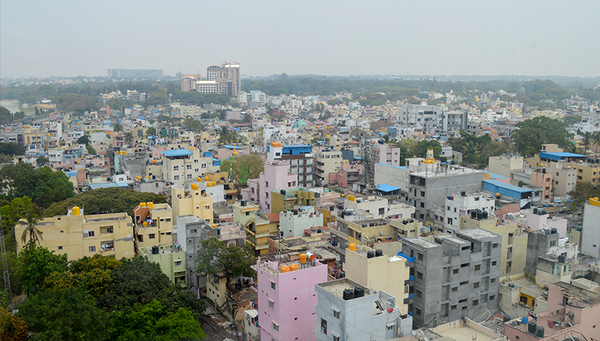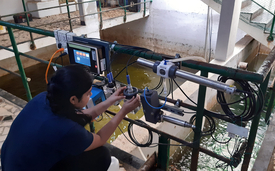News Detail
Improving the microbial quality of recycled water in Bengaluru
April 20, 2023
In Bengaluru, as in many Indian cities, the number of inhabitants has grown strongly in recent years. This is bringing the water infrastructure to its limits. Since 2004, the local regulatory authority therefore mandates 100% wastewater treatment for large apartment buildings. It is also compulsory that all treated water is reused within the building premises, without legal options to otherwise discharge the water. Today, more than 3,000 on-site wastewater treatment plants recycle water, which is mostly used for landscaping and toilet flushing.
However, there is limited information on short-term variations of the microbial water quality from such on-site water reuse systems, as the water quality is only measured once per month in the laboratory. This may be problematic because insufficiently treated wastewater can pose a health risk to users: Domestic wastewater contains high concentrations of pathogens. Users of recycled water can get exposed to pathogens also when the water is not used for drinking. If the recycled water is insufficiently treated, diseases can be transmitted through ingestion or inhalation of even small quantities of water. For instance, aerosols – tiny liquid droplets – are spread when users flush the toilet or during sprinkler irrigation. Additionally, there is also risk of transmission of diseases by touching surfaces that were in contact with recycled water, such as plants irrigated with recycled water.
A recent study of Eva Reynaert, PhD student in the Process Engineering department at the aquatic research institute Eawag and Eberhard Morgenroth, head of the Process Engineering department in collaboration with the Ashoka Trust for Research in Ecology and the Environment (ATREE) evaluated the microbial water quality from on-site water reuse systems in Bengaluru and investigated strategies to improve the microbial water quality.
To improve the quality of the recycled water the researchers recommend automating the chlorination using online sensors like these fixed to the railing of the storage tank for treated water used for toilet flushing.
(Photo: Eawag, Eva Reynaert)
The study reveals that there are short-term variations of the microbial water quality that may endanger user health. However, it is possible to optimize treatment processes and ensure the provision of safe recycled water without requiring significant modifications to existing treatment plant designs. The study describes two specific recommendations:
1. Optimize the biological wastewater treatment to allow for more efficient disinfection with chlorination.
Disinfection of the water is typically achieved by adding chlorine. The efficacy of chlorination depends on the prior treatment steps, especially on the ability of biological wastewater treatment processes to remove ammonium - a form of nitrogen present in the wastewater. If ammonium is still present in the effluent, it will immediately react with free chlorine and can thus consume large amounts of the added chlorine. The chlorine is then no longer available for disinfection. Since aeration is a crucial parameter for the removal of ammonium, the researchers recommend optimizing aeration.
2. Use sensors and automated chlorination to ensure safe waters at all times.
In most sewage treatment plants, chlorine is manually dosed (for instance by turning on a dosing pump) only when the water storage tank is filled. This strategy does not account for changes in the incoming water quality, such as variations in the ammonium concentrations. Besides of increasing the robustness of the biological treatment, the researchers recommend automating the chlorination using sensors. This would allow adapting the amount of chlorine dosed to the quality of the water and avoid having too little or too much chlorine in the water. Additionally, automating chlorination would help prevent regrowth of bacteria in the treated water in-between chlorination events.
Cover picture: More than 3,000 wastewater treatment plants in the Indian city of Bengaluru recycle the wastewater from large apartment buildings on site, which then has to be reused locally as well. (Photo: Eawag, Josianne Kollmann)
Original publication
Reynaert, E.; Nagappa, D.; Morgenroth, E. (2023) Using Sensors and Automated Chlorination to Improve the Microbial Water Quality of On-Site Sewage Treatment Plants in Bengaluru, Research Brief, DOI: https://doi.org/10.3929/ethz-b-000603755
Funding / Cooperations
- Eawag
- Ashoka Trust for Research in Ecology and the Environment
- ETH Zürich


